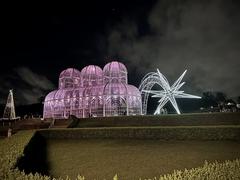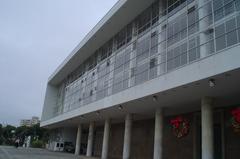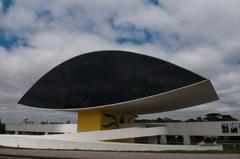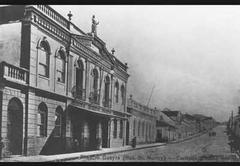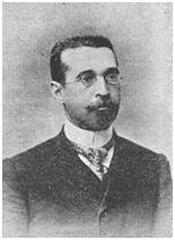Museu Nacional do Espiritismo Curitiba Visiting Hours, Tickets, and Historical Sites Guide
Date: 03/07/2025
Introduction: The Significance of the Museu Nacional do Espiritismo
Located in Curitiba, Brazil, the Museu Nacional do Espiritismo (MUNESPI) stands as a key institution dedicated to preserving and promoting the study of Spiritism—a philosophical and spiritual movement that has profoundly shaped Brazilian culture since its arrival in the mid-19th century. Spiritism, codified by French educator Allan Kardec, centers on core concepts such as the immortality of the soul, reincarnation, and communication with spirits. Introduced to Brazil in 1853, the movement quickly gained momentum and now boasts one of the world’s largest communities of adherents (WisdomLib; Meaningful Moon).
More than a religious current, Spiritism in Brazil is renowned for its impact on social welfare, the arts, and community engagement. Spiritist centers provide charitable services—ranging from medical care to educational programs—especially for underserved populations (Travel Brazil Selection). Spiritist-inspired art forms, such as psychopictography and psychography, further enrich the nation’s cultural landscape.
Founded in 1965 and managed by the Sociedade Brasileira de Estudos Espíritas (SBEE), MUNESPI houses a diverse collection of over 2,000 artifacts, including historic documents, mediumistic works, artworks, and audiovisual records. Its location in the Bacacheri neighborhood places it at the heart of Curitiba’s cultural circuit (MUNESPI Official Site; Bem Paraná).
This guide provides comprehensive information on visiting hours, ticketing, accessibility, collections, and nearby attractions, as well as insights into Spiritism’s cultural and social significance in Brazil.
Table of Contents
- Introduction: The Significance of the Museu Nacional do Espiritismo
- Spiritism in Brazil: History and Cultural Role
- About MUNESPI: Collections, Exhibitions, and Educational Activities
- Visitor Information: Location, Hours, Tickets, and Accessibility
- Guided Tours and Visitor Experience
- Cultural, Academic, and Social Impact of Spiritism
- Museum Amenities and Etiquette
- Safety and Health Protocols
- Suggested Itineraries and Nearby Attractions
- Frequently Asked Questions (FAQs)
- Summary and Visitor Tips
- References
Spiritism in Brazil: History and Cultural Role
Spiritism’s foundation in Brazil dates from 1853 and is rooted in Kardec’s teachings, which emphasize rational inquiry into spiritual phenomena and moral progress. The movement gained institutional support with the creation of the Brazilian Spiritist Federation (FEB) in 1884 (Mystic Sciences). Today, Brazil is home to millions of Spiritists and thousands of centers, with a strong emphasis on charitable action and educational outreach (Meaningful Moon).
Distinct from mainstream religions, Spiritism operates through decentralized study groups and service organizations, blending seamlessly with Brazilian cultural expressions. Artistic practices such as psychopictography (spirit-guided painting) and psychography (spirit writing) are especially influential, while discussion of consciousness and the afterlife permeates broader cultural discourse.
About MUNESPI: Collections, Exhibitions, and Educational Activities
Collections and Exhibits
MUNESPI’s collection captures the evolution of Spiritism in Brazil. Highlights include:
- Archival Documents: Original manuscripts, correspondences, and administrative records tracing Spiritism’s journey from Europe to Brazil.
- Mediumistic Artifacts: Psychographies and psychopictographies—handwritten or painted works created in trance states, including pieces by renowned mediums like Chico Xavier.
- Audio-Visual Materials: Recordings of lectures, séances, and interviews, plus a photographic archive of key events.
- Artworks and Cultural Objects: Paintings, sculptures, and decorative items inspired by Spiritist themes, illustrating the movement’s contribution to Brazilian art.
Educational Programs and Community Outreach
MUNESPI functions as a vibrant cultural hub, hosting:
- Lectures and Seminars: Weekly talks on Spiritist philosophy and history.
- Workshops: Hands-on activities exploring Spiritist literature, art, and practices.
- Film Screenings: Documentaries and films followed by discussions.
- Children’s Programs: Storytelling and educational games introducing Spiritist ideas.
Monthly schedules are available on the museum’s website and social media platforms (Event Calendar).
Visitor Information: Location, Hours, Tickets, and Accessibility
Location
- Address: Rua Guilherme Ihlenfeldt, 663, Bacacheri, Curitiba, Paraná, CEP 82620-035 (MUNESPI Official Site)
- Accessibility: Easily reached by public transport (bus lines Interbairros II/Bacacheri), taxi, or car. Limited street parking available; early arrival is advised for weekends and events.
Visiting Hours
Museum hours vary based on source and possible updates. As of July 2025, the most reliable schedule is:
- Tuesday to Saturday: 10:00 AM – 5:00 PM
- Closed: Sundays, Mondays, and national holidays
Check for updates on the official website or the museum’s Facebook page.
Tickets and Admission
- General Admission: Free for all visitors; voluntary donations are welcome.
- Guided Tours: Free but must be scheduled at least one week in advance (Contact page).
- Special Events: Some may require advance reservation or a nominal materials fee.
Accessibility
- Physical Access: Wheelchair accessible, with ramps and adapted restrooms.
- Inclusivity: Braille labels for select exhibits, audio guides (Portuguese; more languages planned), and assistance for visitors with special needs.
- Service Animals: Welcome throughout the museum.
Guided Tours and Visitor Experience
- Language: Tours are primarily in Portuguese; English may be arranged in advance.
- Group Visits: School and university groups are welcome with prior scheduling.
- Visitor Flow: The museum attracts 2,000–3,000 visitors annually, with peaks during Spiritist commemorative dates.
- Explanatory Panels: Primarily in Portuguese, with selected English and Spanish translations; QR codes provide extra information and audio guides.
Cultural, Academic, and Social Impact of Spiritism
Negotiating Identity and Syncretism
Spiritism in Brazil exemplifies cultural adaptation, blending with Catholic traditions and Afro-Brazilian religions like Umbanda and Candomblé. MUNESPI’s displays reflect this hybridity, showcasing artifacts and narratives that illustrate the interweaving of faiths (SciELO).
Charity and Social Practice
Spiritist centers are renowned for philanthropic work—free clinics, food distribution, and educational programs. The museum documents and celebrates these initiatives, highlighting Spiritism’s role in promoting social justice and well-being (Travel Brazil Selection).
Academic Contributions
MUNESPI is a resource for scholars, preserving archival material and hosting conferences. The museum collaborates with universities and researchers, supporting the academic study of Spiritism’s history, philosophy, and societal contributions (SciELO).
Spiritism and Public Discourse
Spiritist ideas are discussed widely in Brazilian media, literature, and popular culture. The museum fosters public dialogue, dispelling misconceptions and promoting interfaith understanding.
Spiritism in Curitiba
Curitiba’s cultural vibrancy and social innovation have provided fertile ground for Spiritist organizations and MUNESPI’s outreach, making the museum an active participant in community life.
Museum Amenities and Etiquette
- Gift Shop: Offers Spiritist books, souvenirs, and local crafts (mainly Portuguese).
- Reading Room: Over 3,000 Spiritist works available for study.
- Wi-Fi: Free for visitors, supporting digital content and audio guides.
- Restrooms: Clean, accessible facilities on both floors.
- Food: No on-site café, but several restaurants and snack bars are nearby.
Visitor Etiquette: Maintain respectful behavior, especially in reading rooms and during events. Photography is allowed in most areas without flash or tripods; ask staff for permission to photograph specific items for research.
Safety and Health Protocols
- Hygiene: Enhanced cleaning and hand sanitizer stations throughout the museum.
- Masks: Optional as of July 2025; check Health and Safety Updates for the latest guidelines.
Suggested Itineraries and Nearby Attractions
- Bacacheri Park: 1.5 km from the museum, ideal for relaxation.
- Museu Egípcio e Rosacruz: Explores Egyptian history and Rosicrucianism (Museu Egípcio e Rosacruz).
- Historic Downtown Curitiba: Easily accessible, offers landmarks, markets, and cultural venues.
Sample Itinerary: Morning at MUNESPI, lunch locally, afternoon at Bacacheri Park or Museu Egípcio e Rosacruz.
Frequently Asked Questions (FAQs)
Q: What are the museum’s visiting hours?
A: Tuesday to Saturday, 10:00 AM to 5:00 PM. Closed Sundays, Mondays, and national holidays.
Q: Is admission free?
A: Yes, general admission is free; donations are welcome.
Q: Are guided tours available?
A: Yes, in Portuguese by appointment. English tours may be arranged in advance.
Q: Is the museum wheelchair accessible?
A: Yes, with ramps, adapted restrooms, and Braille labels.
Q: Can I take photos inside the museum?
A: Yes, except where signage prohibits it. No flash or tripods allowed.
Q: How do I get to the museum by public transport?
A: City bus lines (Interbairros II, Bacacheri) stop within walking distance.
Summary and Visitor Tips
The Museu Nacional do Espiritismo offers a multifaceted exploration of Spiritism’s influence in Brazil. Through its thoughtfully curated collections, educational programs, and accessible facilities, the museum provides a welcoming space for all visitors to engage with Brazilian spiritual heritage (MUNESPI Official Site; Guia da Semana). MUNESPI’s active role in community outreach and academic collaboration highlights Spiritism’s ongoing relevance in cultural, social, and public life (SciELO; Travel Brazil Selection).
Practical Tips:
- Confirm visiting hours before your visit.
- Book group visits and guided tours in advance.
- Bring translation tools if you do not speak Portuguese.
- Explore nearby attractions for a full cultural day in Curitiba.
- Follow museum etiquette, especially regarding photography and respectful behavior.
For up-to-date information, visit the official website or Facebook page. Download the Audiala app for audio guides and enhanced visitor resources.
References
- Museu Nacional do Espiritismo in Curitiba: Visiting Hours, Tickets, and Spiritism History in Brazil, 2025 (WisdomLib)
- Spiritism in Brazil: Exploring the Spiritual Journey, 2025 (Meaningful Moon)
- Spiritism a Popular Religion in Brazil, 2025 (Mystic Sciences)
- MUNESPI Official Site, 2025 (MUNESPI Official Site)
- De Arte Indígena e Objetos Espíritas: Cinco Museus para Visitar em Curitiba, 2025 (Bem Paraná)
- MUNESPI: Visiting Hours, Tickets & Unique Collections, 2025 (Guia da Semana)
- Negotiating Identity and Spiritism in Brazil, 2025 (SciELO)
- Travel Brazil Selection: Spiritism, 2025 (Travel Brazil Selection)

